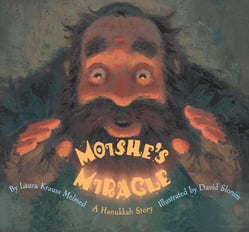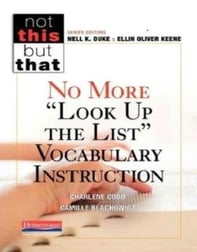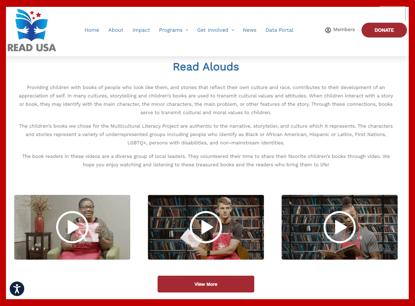This Week at READ USA
New Read Aloud Series Coming Soon!
- Read USA Inc.
- December 14 2022
The team at READ USA is thrilled to be releasing a brand new Read Aloud series very soon!
What do books, art, servant leadership, and diversity have in common? We can’t wait to tell you!
Read Alouds are part of READ USA’s Multicultural Literacy programming, a key component of our evidence-based, four-pillar approach to solving the literacy crisis in our country.
We launched our first Read Alouds in early 2020 when the COVID-19 pandemic prevented us from hosting our annual Book Fairs. Since that time, we have expanded this important literacy resource to include more local leaders who volunteer their time to share a favorite children’s book in which they identify with the character(s). The READ USA Multicultural Literacy library also now includes additional tools and resources for parents and teachers to inspire young readers and promote more cultural awareness, inclusion, equity, and understanding in our community.
Click here to watch our Read Alouds and stay tuned for an exciting update!
#ICYMI: “READ USA has done the hard part…”
“READ USA has provided every opportunity, for every student, to have access to what they need to have that gap bridged.”
In case you missed it, watch Tracey Brown, a teacher at Don Brewer Elementary School and a READ USA Site Coordinator, explain the power behind READ USA Literacy Tutoring:
Your support is closing the literacy gap in Duval County and beyond, and we only have until Dec. 31st to secure a $1 million donation matching opportunity to help keep our momentum going.
Will you help us achieve this goal? Click here for more information and to make a match eligible, four-year donation commitment of any amount by the end of this year.
Children’s Book: Moishe’s Miracle: A Hanukkah Story, by Laura Krauss Melmed

Illustrated by David Slonim
As Moishe receives a disappointing gift from a stranger, he begins to realize the promise that comes with it. From a dented and unimpressive pan, he will realize all his Latke dreams! If the pan is on the fire, it will bring forth as many Latkes as his heart could hope for. But this comes with limits. The latkes are only for Moishe. What will Moishe learn from this parable? A perfect picture book to begin Hanukkah this year, Moishe’s struggles, joys, and bright emotion spreading across the page will surely get you ready to celebrate!
Submitted by Tabetha Cox, Tutoring Program Director
Education Corner -The Five Pillars of Reading: Vocabulary
“One must be drenched in words, literally soaked in them, to have the right ones form themselves into the proper pattern at the right moment."
-Hart Crane, American poet
This week we will be looking at the Vocabulary component of reading and ways to help students grow in this area.
- Phonological awareness – awareness of the sound structure of words
- Phonics – correlating sounds with letters or groups of letters
- Fluency – accuracy, rate and expression while reading
- Vocabulary – the body of words a child has learned
- Reading comprehension – the understanding and interpretation of what is read
Infants and toddlers who do not yet have command over the English language have a very large receptive vocabulary. They understand many commands and simple sentences. Parents of infants who read and talk to their infants and toddlers know exactly what they are doing to build their small one’s vocabulary! Consider a beginning reader who comes to the word “fly” in a book. As they begin to figure out the sounds represented by the letters f,l,y, they recognize that the sounds make up a familiar word they have heard or said before. Add to that the multiple meanings of the word fly and it’s easy to see why it’s harder for a young reader to figure out words that are not already part of their speaking vocabulary. The children who have been consistently read to and talked to are those who are better equipped to quickly decode and comprehend new vocabulary.
The diagram below illustrates the four parts of Expressive and Receptive Vocabulary:
|
|
Receptive (Recognition) Vocabulary |
Expressive (Productive) Vocabulary |
|
Speech |
Listening vocabulary |
Speaking vocabulary |
|
|
Reading vocabulary |
Writing vocabulary |
Our receptive, or listening, vocabularies are often far advanced of our speaking, reading, or writing ones, especially in the early grades. Students may know they are talking about a dinosaur but are unable to read or write the word. Students’ receptive vocabularies can be at least two grade levels higher than their expressive vocabularies (Biemiller & Slonim, 2001). We can expand students’ receptive vocabulary by reading to children from texts with more difficult vocabulary than they use themselves. Because the range of oral vocabularies students bring to school is so wide (Hart & Risley, 1995; Graves, 2006), enrichment of oral vocabularies through read alouds with complex texts is an important component of all elementary curriculum. Obviously, we want to develop all four vocabularies: oral, expressive, reading, and writing, so instruction needs to be tailored toward these different kinds of vocabulary as well as immersion in a content rich curriculum (Cobb & Blachowicz, 2014).
Here are some fabulous ways to boost your child’s vocabulary from Understood.org.
- Describe the word. Provide a description of each new word you introduce. For example, maybe you’re teaching your child the word merchant, which is common in upper elementary social studies textbooks. You can talk with your child about the localmerchants in your town. What kinds of stores are in your town? What do they sell?
- Say it your way. Once you’ve described a new word, it helps to ask kids to come up with their own way to describe it. For example, after explaining how fortunateyou are to have such a nice family, your son or daughter might explain how fortunatethey feel to have the latest video game.
- Act it out. By acting out a word, your child is bound to better understand it. This may be particularly helpful if your child has lots of energy and loves to run around. The new word frolic, for example, can come alive through jumping around like a puppy, goat, or lamb. Why not bring the fun outdoors as well? Frolic in the garden, yard or along the sidewalk.
- Quick draw. Get some pencils and paper. Without using actual words, draw a quick sketch of what the new word is. For the word, reluctant,you might decide to represent it by drawing a person standing at the edge of swimming pool with only one toe in the water. Your child, who is reluctantto eat vegetables, might draw a big bowl of broccoli and a frown face next to it.
- Analyze this. Teach your child the meanings of common prefixes, suffixes and root words. For example, the prefix multi-means manyand the suffix -less means not or without. Geo is a root word that means earth, as in geology. Recognizing these patterns will help your child with word meanings and understanding.
- Write a story. Using a list of new words, ask your child to be an author and write a story. In order to do this well, your child will need to use all of the words correctly. Bringing words together into story-form from a list will take imagination. Encourage your child to be creative and have fun.
- Tell me once, tell me twice…Use the new word all the time. So, if the word is essential, you might talk about what is essentialto pack for a camping trip or discuss what is essentialfor happiness. A checklist of essential chores might help remind your child to walk the dog, do homework and set the table before dinner. https://www.understood.org/en/articles/7-ways-to-improve-vocabulary
For a quick, very informative read on best vocabulary instruction practices, look for this title:



